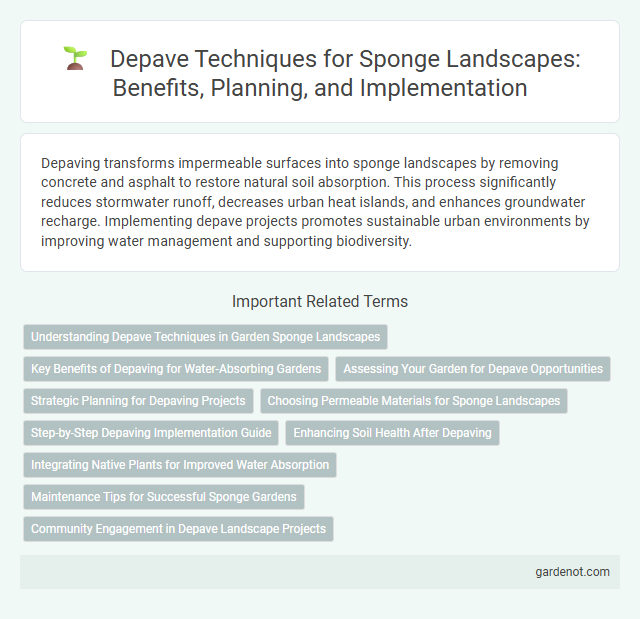Depaving transforms impermeable surfaces into sponge landscapes by removing concrete and asphalt to restore natural soil absorption. This process significantly reduces stormwater runoff, decreases urban heat islands, and enhances groundwater recharge. Implementing depave projects promotes sustainable urban environments by improving water management and supporting biodiversity.
Understanding Depave Techniques in Garden Sponge Landscapes
Depave techniques in garden sponge landscapes involve the removal of impermeable surfaces like concrete or asphalt to restore natural soil absorption and enhance water infiltration. These methods improve stormwater management by promoting groundwater recharge and reducing runoff, thus creating healthier, more sustainable garden environments. Utilizing tools such as jackhammers, shovels, and wheelbarrows, depaving supports the transformation of urban spaces into sponge landscapes that mimic natural hydrological cycles.
Key Benefits of Depaving for Water-Absorbing Gardens
Depaving transforms impermeable surfaces into water-absorbing gardens, significantly enhancing stormwater management by reducing runoff and promoting natural groundwater recharge. This process improves soil health and increases biodiversity by allowing native plants to thrive in restored landscapes. Homeowners and urban planners benefit from decreased flooding risk and cooler microclimates due to improved water infiltration and green space expansion.
Assessing Your Garden for Depave Opportunities
Assess your garden for depave opportunities by identifying impervious surfaces such as concrete patios, driveways, or walkways that impede natural water infiltration. Measure the total square footage of these areas to prioritize sections that will maximize stormwater absorption and reduce runoff. Evaluate soil conditions and existing vegetation to determine the best approach for transforming paved spaces into functional, permeable landscapes that enhance groundwater recharge.
Strategic Planning for Depaving Projects
Strategic planning for depaving projects involves assessing impervious surfaces to prioritize areas with high stormwater runoff and low permeability. Incorporating GIS mapping and soil infiltration tests enhances decision-making by identifying optimal sites for sponge landscapes that maximize water absorption. Effective stakeholder collaboration ensures project goals align with environmental benefits and community needs, promoting sustainable urban water management.
Choosing Permeable Materials for Sponge Landscapes
Selecting permeable materials such as porous concrete, permeable pavers, and gravel is essential for enhancing water infiltration in sponge landscapes. These materials allow rainwater to seep through surfaces, reducing runoff and promoting groundwater recharge. Incorporating permeable options improves drainage, mitigates flooding risk, and supports sustainable urban water management.
Step-by-Step Depaving Implementation Guide
Depaving involves systematically removing impermeable surfaces to restore natural ground cover and improve stormwater management. Start by assessing the site, mapping out areas for removal, and obtaining necessary permits; next, carefully demolish existing pavement while minimizing soil compaction; finally, amend the soil with organic materials and replant native vegetation or sponge landscape elements to enhance water infiltration and support local ecosystems. Following these steps ensures effective depaving that promotes sustainable urban drainage and reduces runoff-related flooding.
Enhancing Soil Health After Depaving
Depaving improves soil health by restoring natural infiltration and reducing surface runoff, which enhances microbial activity and nutrient cycling in urban landscapes. Removal of impervious materials allows for increased organic matter accumulation, promoting soil structure and moisture retention vital for plant growth. Incorporating native vegetation after depaving further stabilizes soil and supports a resilient ecosystem.
Integrating Native Plants for Improved Water Absorption
Depave projects prioritize integrating native plants to significantly enhance water absorption in sponge landscapes, leveraging their deep root systems and natural adaptation to local climates. Native vegetation improves soil structure, increases permeability, and reduces runoff, effectively managing stormwater in urban environments. This approach supports biodiversity while promoting resilient and sustainable drainage solutions.
Maintenance Tips for Successful Sponge Gardens
Regularly inspect sponge gardens to prevent soil compaction and ensure proper water absorption. Remove debris and invasive plants to maintain soil health and encourage native vegetation growth. Implement seasonal mulching and monitor moisture levels to support long-term sponge landscape functionality.
Community Engagement in Depave Landscape Projects
Community engagement in Depave landscape projects fosters local collaboration to remove impervious surfaces and replace them with permeable, green spaces. Volunteers actively participate in soil restoration, native plant planting, and creating rain gardens, which enhance urban water absorption and biodiversity. These community-driven efforts promote environmental stewardship while improving neighborhood aesthetics and resilience to stormwater runoff.
Depave Infographic

 gardenot.com
gardenot.com